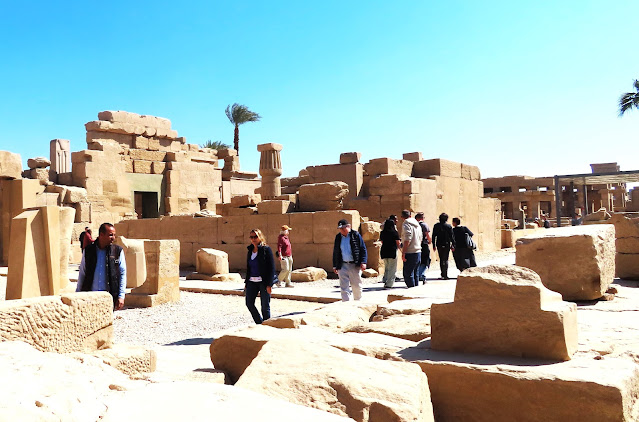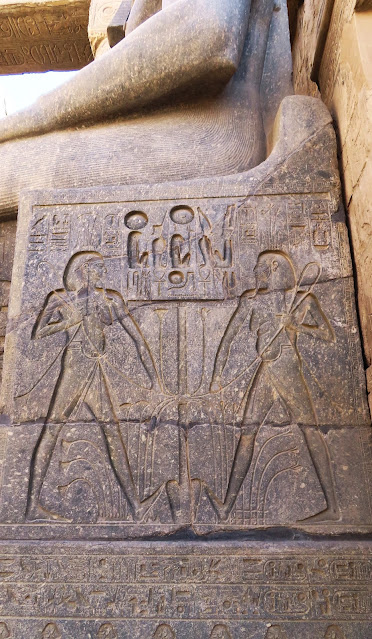What visit to Egypt is complete without a cruise down the Nile? Our day started early with a flight to the modern city of Luxor, where
we would board our cruise ship, the Moon Goddess, and spend five of the most
memorable days of our entire trip. Today
we explored the mighty temples of Karnak and Luxor.
 |
| Looking down on the barren landscape of Egypt. |
Luxor has gone through several reincarnations. In ancient
Egyptian times, it was called Wassat. Those of us who love Greek history
will recognize its Greek name of Thebes, the great capital city of the New
Kingdom of Egypt. The Arabic name is Al Luxor, the "City of the
Palaces."
To better understand the temples' historical place in history,
let's back up a little with a quick summary of the three major periods of
ancient Egypt: The Old Kingdom, from 2,700 to 2,200 BC, the Middle
Kingdom, from 2,050 to 1,800 BC, and the New Kingdom, which started around
1,500 and lasted until about 1,100 BC.
The Great Temple of Karnak
The Great Temple in Karnak was built near the beginning of the
New Kingdom, during the 18th Dynasty, around 1,500 B.C. It is dedicated
to Amun Ra, the Sun God, and the supreme god of ancient Egypt, and it is the
largest religious complex in history. Although not all the original
buildings still stand, what does remain left me open-jawed with
amazement.
We met our new guide, Deda, and made a brief stop in the Visitors Center where we learned a bit about the history of Karnak. (Quick side-story: Deda's actual name is Ahmed. Close to half of the wonderful people who helped us throughout our tour were named Ahmed: the owner of the tour company we used, High End Journeys, our greeters in the airport, two of our drivers, receptionists in some of our hotels – and the other 49% were named Mohammed! We did have one driver named Said and one guide named Saif, but Ahmed and Mohammed held the name trophies! Deda introduced himself as “Ahmed but call me Deda.” And our sweet and eager-to-please room steward at our Cairo hotel said, when we asked his name, “Well my name is Mohammed, but everybody’s name is Mohammed, so call me Gamel.”)
 |
A model of the Temple of Karnak as it would have looked when first built
stood in the Visitors Center |
 |
| The back of the temple, including the Sacred Pool. |
After the Visitors Center, Deda led us across the large field toward the
towering walls of the front of the complex where we entered the temple over a
bridge lined with ram-headed sphinxes, each protecting the image of a pharaoh. The bridge crossed a dry gully where a tributary of the nearby Nile River had once
flowed.
 |
| Approaching the great outer walls of Karnak |
 |
| A small mosque and more excavations in front of the temple |
 |
| The bridge into the entrance of the Temple of Karnak |
 |
| Rob and me in front of the bridge of Ram Sphinxes |
 |
Ram Sphinxes guard the Great Temple of Karnak
Rams were the symbol of the great God Amun |
Through the enormous entry gates, we entered a large
courtyard. If you have ever wondered how the ancient people built such
immense walls, we found the answer inside. Mounds of small bricks, which
acted as "scaffolding," remain piled against one of these
walls. Once the great limestone walls were finished, the bricks would have
been removed. One side of this courtyard was also lined with Ram Sphinxes.
 |
| The great courtyard inside the entrance to Karnak |
 |
| The pile of smaller bricks was the "scaffolding" used to build the high walls. |
 |
| Deda points out features of the Temple of Karnak |
 |
| The great courtyard |
 |
| I enjoyed the many Ram Sphinxes |
I gasped as we entered the most wonderful part of Karnak,
the Great Hypostyle, built by Seti I and his son, Ramses II. It is a
courtyard filled with 134 huge thick columns reaching into the sky far above
our heads and still covered with hieroglyphs and images of the Pharaohs and gods.
I was once again reminded that our image of ancient ruins as bare white marble
or beige rock is inaccurate, as many of these columns still displayed the many
colors that had once decorated them. Remnants of the ceiling that had
once covered the room lay between some of the columns. I felt almost
overwhelmed by the enormity of the chamber - and a little frustrated that my
camera simply could not capture the beauty and grandeur of the room.
 |
For you art and history lovers, here is the plaque that describes
the design and purpose of the Hypostyle. |
 |
| The crowds entering the main nave of the Hypostyle |
The enormous columns dwarfed the visitors below.
The Hypostyle was once a covered chamber. The beams of the roof were
still visible between some of the columns.
I was awe-struck by the hieroglyphics and painting engravings that
still cover almost every inch of these massive columns.
 |
| Exiting the Hypostyle |
Behind the Hypostyle is the most sacred room in the temple, the inner sanctum containing a pedestal which once held a statue of Amun Ra made of 10 kilograms of pure gold.
 |
| The pharaohs worshipped Amun Ra in the inner sanctum. |
 |
| A gold statue of Amun Ra once stood on this platform. |
Beyond the Hypostyle and Sanctuary were two remaining obelisks, one dedicated
to Tuthmosis I and one to his daughter, Hatshepsut. These tall towers are
each carved from one solid piece of granite and weigh more than 50 tons.
The complex used to contain more obelisks, but the rest of them are now
scattered throughout the world, stolen, or bought, by other nations before the
Egyptians of the 1800s understood what a treasure they had.
 |
| The obelisks were visible from all the ruins at the back of the Temple of Karnak |
Near the obelisks were large statues of Ramses II, Ramses VI,
Tuthmosis III, and Amun Ra, and an avenue filled with statues of various pharaohs.
 |
| Ramses II |
 |
| These are also images of Ramses. They hold the ankh, the symbol of life. |
 |
| An avenue of Pharaohs |
At the back of Karnak are many more ruins of administrative buildings, palaces, and other parts of the temple, as well as the Sacred Lake, used by the temple priests for cleansing and purification rituals. This lake has contained water for over 3,000 years!
 |
| Walls of the buildings at the rear of Karnak |
 |
| This is a statue of the sacred Scarab Beetle, who was a symbol of renewal and rebirth. |
 |
| Ruins of temple buildings |
 |
| Engravings of the Egyptian Gods |
 |
| The Sacred Lake |
The Temple of Luxor
I could have happily spent many more hours exploring Karnak, but it was time to move on to the "Southern House" of the
complex, the Temple of Luxor, dedicated to Amun Ra's wife, Mut, and their son,
Khonsu, the God of the Moon.
 |
| The Temple of Luxor |
The three kilometers between the big temple and
this much smaller one on the banks of the Nile was once an avenue lined with
Sphinxes. During the annual Opet Festival, the priests would place the statue of
Amun Ra into a barge, which they carried down the Avenue of the Sphinxes from
the Great Temple to Luxor.
 |
| Part of the Avenue of the Sphinxes still exists. |
 |
| A replica of the ceremonial barge |
The Luxor temple was also built during the 18th Dynasty by the
Pharoah Amenhotep III, who was the grandfather of King Tut
(Tutankhamen).
Luxor presents a visual timeline of Egyptian history. High
on one of the outer walls is a mosque, which is built over a Christian church,
which is built on top of the ancient temple. At one time, the village of
Luxor sat atop the rubble and sand that covered this entire complex.
There are photos of residents standing next to the heads of the pharaohs'
statues, either not knowing or not caring that the rest of the statues waited
below the soil. Eventually, the government moved the residents of the
village into new homes while archaeologists began the task of uncovering the
temple.
 |
| A Muslim Mosque on top of a Christian Church on top of an Egyptian Temple |
 |
Look at the residents of Luxor standing in front of the Temple of Luxor -
then look at the photo below of the very same statues today! |
 |
| The Temple of Luxor today |
Behind the massive Pylon entrance are the courtyards and shrines of the temple. In the Sun Court of Amenhotep III, Deda pointed out the unique columns of the temple,
graceful, fluted towers representing bundles of papyrus.
Throughout the grounds of Luxor are statues of pharaohs and engravings showing their exploits in war and in trade.
 |
| Rob stands in front of Ramses II |
 |
| Ramses II |
 |
| This engraving may be depictions of warriors or slaves |
 |
| This engraving shows that ancient Egypt was communicating with sub-Saharan Africa |
 |
| More statues of Ramses II |
 |
| My research did not discover the identity of this royal couple seated in Luxor. |
We walked to the
Sanctuary at the back of the temple, which was rebuilt by Alexander the Great,
as a tribute to his "father," Amun Ra! This was amusing,
as we know that Alex's father was Philip of Macedonia. But Alexander was
nothing if not ambitious. He loved Greece and added it to his mighty
empire by declaring himself a god and becoming a pharaoh. It is
speculated that the priests allowed it because he promised to restore the
temples, and indeed, he did.
During the Roman Empire's occupation of Egypt, the Romans turned the Luxor Temple complex into a fort and the sanctuary into a
Roman chapel. The building now has a distinctive Roman facade. Because the room had remained enclosed, the paintings and engravings on the walls remained vivid.
 |
| A Roman arch covers the entrance to the sanctuary. |
 |
This temple was originally dedicated to the goddess Mut.
It later became a Roman temple and eventually a church. |
 |
| Engravings inside the sanctuary |
We had spent the entire morning and early afternoon exploring
these incredible sights, but we got to spend the rest of the day settling into
our stateroom on board the Moon Goddess cruise ship, one of the many boats
floating down the Nile River. From our balcony, we could see the Temple
of Luxor, which sits on the banks of the Nile, glowing in the sunset.
 |
| Our Nile Cruise Ship, the Moon Goddess |
 |
| Tourists explore Luxor by horse buggy |
 |
| The Temple of Luxor seen from our balcony aboard the Moon Goddess |
 |
| Sunset over the Nile |
 |
| The end of one of my favorite days of the trip. |















































































No comments:
Post a Comment